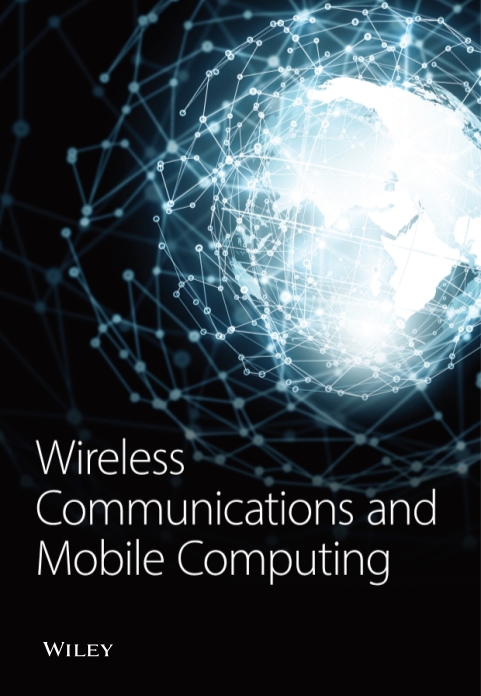Hierarchical Optimization Scheduling of Active Demand Response for Distribution Networks in 5G Base Stations
Abstract
The study aims to solve the problem that the traditional scheduling optimization model does not apply to the multimicrogrid systems in the 5th generation mobile networks (5G). First, the response characteristics of the 5G base station energy storage demand are analyzed. Second, a microgrid hybrid power supply system is proposed. Third, a multimicrogrid demand response hierarchical optimal scheduling model based on the game is constructed, and the game interaction mechanism between various stakeholders in the demand response is studied. Finally, the strategy of each microgrid in the IEEE-9 bus system in the game bidding is simulated by a genetic algorithm (GA), and the simulation experiment is carried out by Matlab. The results show that (1) after the optimization of the multimicrogrid system, the overall load of the microgrid is reduced, the independent energy optimization is carried out according to the energy access of each microgrid, and renewable energy is fully used. (2) Based on the game-based time-sharing bidding strategy, the system gives priority to the low-cost microgrid for power supply and saves the cost. (3) The load transfer capacity of the three microgrids obtained by the model are 132.7 kW, 47.1 kW, and 46.4 kW, which is within the actual load range of each microgrid; their electricity sales are 665.8 kWh, 2053.3 kWh, and 1668.2 kWh; and their income is 132.45 CNY, 411.72 CNY, and 354.63 CNY, respectively. This shows that the game equilibrium index makes the power sales of each microgrid proportional to its income, which ensures the fair and effective scheduling in the bidding process. The study provides technical support for the construction of a 5G base station and the active demand response scheduling optimization of distribution networks.
1. Introduction
Recently, the 5th generation mobile networks (5G) develop rapidly and are used worldwide. They bring great convenience to people’s life [1]. The size of 5G base stations is expanding in response to the increasing network transmission demand. Compared with the 4th generation mobile networks (4G) base stations, the network transmission speed is faster, but their energy consumption is also 3~4 times that of 4G base stations. Therefore, reducing energy consumption is an urgent problem to be solved in the construction of 5G base stations [2]. The new energy, such as wind power and photovoltaic power, provides a new idea to solve the energy consumption problem of the 5G base station, and the microgrid is one of them [3]. The microgrid is a micropower system that integrates distributed power generation, energy storage, and the load for management and control. It can effectively absorb renewable energy with the characteristics of randomness, intermittency, and volatility. Therefore, it can improve the reliability of the power supply, reduce costs, and save energy [4]. New energies and the flexible intelligent loads are connected to the demand of the distribution network in the form of a microgrid and participate in power grid scheduling through demand responses [5]. However, there are many stakeholders in the scheduling process of distribution networks, and the distribution of interests is a research hotspot.
Dou et al. (2020) proposed a microgrid system combining photovoltaic power generation and cogeneration to improve the photoelectric absorption capacity. Particle swarm optimization (PSO) is employed to realize the economic scheduling of the microgrid to minimize the operation cost of microgrids. The simulation results show that this scheme improves the photoelectric consumption level and the economic benefits of microgrids [6]. Ma et al. (2021) used the free space of the 5G base station to stabilize photovoltaic outputs and built a photovoltaic energy storage microgrid. On this basis, a two-tier optimal configuration model is proposed to optimize energy sharing between the microgrids in the base station, minimize the annual average comprehensive income of the 5G base station microgrid, and optimize the capacity of the photovoltaic storage system. The simulation results show that the model can reduce the cost and the peak load of the power grid, making the photovoltaic power generation absorbed locally [7]. Yue et al. (2021) proposed a demand response operation method of the regional electrothermal integrated energy system based on the energy storage ability of the 5G base station in response to its scheduling problem. The experimental results show that this method can realize wind power utilization, economic scheduling, and peak valley difference reduction through demand and response and improve the economic efficiency, environmental protection, and low-carbon operation of the regionally integrated energy system [8]. Lee et al. (2021) suggested a hybrid optimization microgrid operation method based on the game theory. The game theory is used to reduce the operation cost of microgrids and the cost of the battery energy storage system, and then, the optimal capacity of the battery energy storage system is obtained. And the optimal demand response capacity is determined based on the incentive value and the capacity [9]. Huang et al. (2020) proposed a peer-to-peer (P2P) energy trading model based on the photovoltaic distributed generation, the battery energy storage system, and a P2P power trading mechanism based on the alliance game theory. The simulation results show that this mechanism can encourage individual customers to participate in P2P power transactions, help reduce power costs, benefit from the increase of power supply, and make grid operators make the most economic and socially friendly decisions [10].
Based on the above research results, it is found that the application of microgrids and game theory to the construction of 5G base stations and demand response scheduling optimization of distribution networks is mature. However, most studies only focus on a single microgrid. With the expansion of the construction scope of 5G base stations, the multimicrogrid system in a certain area is popularized to ensure the reliability and quality of the base stations at the end of the distribution network. The traditional scheduling optimization model for single microgrids is not suitable for multimicrogrids. In terms of the problems, the response characteristics of the energy storage demand of 5G base stations are analyzed, and a microgrid hybrid power supply system is proposed. On this basis, a multimicrogrid demand response hierarchical optimal scheduling model based on the game theory is constructed. The innovation is that the game theory is introduced into the multimicrogrid demand response scheduling of 5G base stations. The study provides technical support for the construction of 5G base stations and the optimization of active demand response scheduling of distribution networks.
2. Establishment of System and Model
2.1. Response Characteristics of Energy Storage Demand
2.1.1. Equipment
The equipment includes power supply equipment and communication equipment. The power supply equipment is composed of a power supply and energy storage battery, and the communication equipment consists of a source antenna unit, a baseband unit, and network transmission equipment [11], as shown in Figure 1.
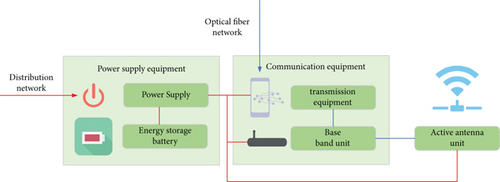
The main function of 5G communication equipment is to send, receive, and process wireless signals based on 5G core networks, and it is the interface between mobile terminal equipment and 5G networks [12]. The transmission equipment is to access the 5G network and interact with the 5G networks in the specified protocol and mode [13]. The baseband unit is to process baseband digital signals, which has the functions of Fourier transform (FM), modulation/demodulation, and channel coding/decoding. The source antenna unit has an antenna array and a radio frequency (RF) unit of the previous generation base station. 5G communication is to improve the channel capacity by replacing the traditional antenna with a multiantenna array [14]. The source antenna unit can convert the digital intermediate frequency (IF) signal into an analog signal through a digital/analog (D/A) module, and finally, send it by multiantenna array after power amplification. It can also convert the received radio signal into a digital signal [15].
The power supply provides direct current (DC) power for communication equipment to ensure its normal operation. It supplies the power by converting alternating current (AC) into DC in the distribution system, and the energy storage battery is a power supply, which ensures the normal operation of the base station in case of failure of the distribution system [16]. Lead-acid batteries are widely used in previous generations of base stations, but it does not meet the needs due to the high-power consumption and low-energy density. And the lithium-ion battery is used [17].
2.1.2. Load Demand
The load demand falls into AC load and DC load, as shown in Figure 2.

The load includes lighting load and air conditioning load, which are AC load. The DC load has an active antenna unit load, a baseband unit load, and a network transmission load [18]. Among them, the power consumption of the source antenna unit is the highest, accounting for 90% of the total. The power consumption of the source antenna unit can be subdivided into power amplification, small signal, digital IF, and power consumption. And its power will change with the change of the communication load of the base station [19].
Affected by communication load, 5G base stations have the potential to meet the demand. First, the power consumption of all equipment in the base station can be flexibly adjusted. Second, the communication load is different in each period of the day, and the equipment power consumption of base stations will change accordingly. The minimum standby capacity of the energy storage battery can ensure the normal operation of the base station. The capacity of the energy storage battery can be dynamically divided into two parts according to the communication load of the base station, namely, the power supply backup part and the flexible scheduling part. Therefore, the energy storage battery can be used as a time-varying capacity energy storage to meet the demand [20].
2.2. Microgrid Hybrid Power Supply System
A microgrid is a combination of distributed generation systems and different loads at the voltage level of the distribution network, so it is essentially an active distribution network [21]. A microgrid hybrid power supply system is presented for 5G base stations. The structural framework of the system is shown in Figure 3.
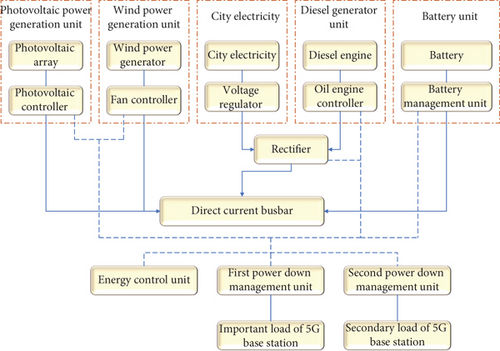
Figure 3 shows that the system includes five units: photovoltaic power generation, wind power generation, municipal power generation, diesel power generation, and battery. Among them, the system takes photovoltaic power generation and wind power generation as the main power supply, municipal power as the auxiliary power supply mode, and diesel engine power generation and battery as the supplement. Photovoltaic power generation, wind power generation, and battery units are directly connected with the DC bus of the system, and the utility unit and the diesel generator unit are connected with the DC bus through a rectifier. The DC bus is, respectively, connected with the important load and the secondary load through the first power down management unit and the second power down management unit. The connections between the DC bus and the energy control unit and between the first power management unit and the second power management unit are represented by dotted lines to make the relationship between the modules clearer. The energy control unit supplies power to the base station load by balancing and controlling all the units, and the arrangement of the power supply is photovoltaic power generation unit, wind power generation unit, commercial power unit, the battery unit, and diesel engine power generation unit. The power supply of the microgrid hybrid system is shown in Figure 4.
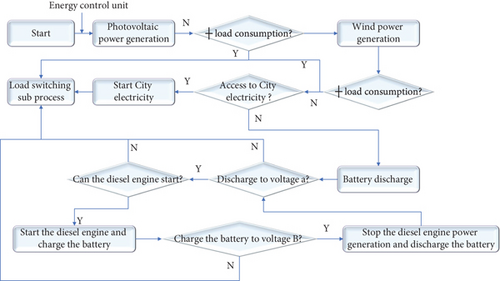
Figure 4 shows that the system generates power by controlling the photovoltaic power generation unit through the energy control unit. If the photovoltaic power generation is greater than or equal to the load power consumption, the power supply will enter the load switching subprocess. If not, a wind power generation unit is required. If the sum of photovoltaic and wind power generation still does not reach the load power consumption and the municipal power can supply power normally, the power supply will turn to the municipal power. If the municipal power cannot supply power normally, the energy storage battery discharge of the power supply equipment needs to be controlled by the energy control unit. In this case, photovoltaic power generation, wind power generation, and battery discharge cooperate to supply power to the base station load. If the energy storage battery is discharged to specific voltage a and the diesel engine can be started normally, the battery discharge stops and switches to the charging state, making the diesel engine start discharging. If the diesel engine cannot be started normally, the battery will continue to discharge and enter the load switching. When the battery is charged to voltage b, the diesel engine discharge stops and switches to the battery power supply. The load switching process of the system is shown in Figure 5.
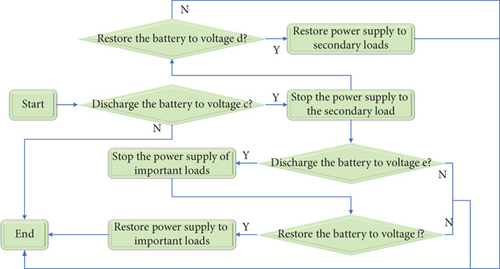
In the load switching process, the system first judges whether the energy storage battery is discharged to voltage C through the energy control unit. If so, it controls the second power down management unit to stop the power supply of secondary load. Otherwise, the control ends. If the battery recovers to voltage d, the power supply to the secondary load is restored. If the battery is discharged to voltage e, it is necessary to stop the power supply of important loads by controlling the first power down management unit. When the battery returns to voltage f, the power supply to the important load will be restored. Or, the control will be ended, and the above voltages a, b, c, d, e, and f increase in turn.
2.3. Multimicrogrid Demand Response Hierarchical Optimal Scheduling Model Based on Game
2.3.1. System Scheduling Framework of Multimicrogrid
Multimicrogrid is discussed to enable 5G base stations to obtain a stable power supply [22]. It is an interactive coordination management system with multiple microgrids and can improve the reliability and quality of the power supply at the end of the distribution network [23]. In the system, photovoltaic and wind power generation are renewable energy generators, which are uncontrollable units. The energy storage battery and diesel engine in the base station are controllable units. Based on this, the scheduling framework of the multimicrogrid system is proposed, as shown in Figure 6.
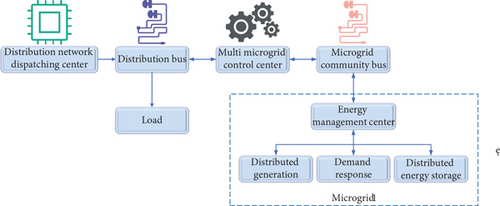
Figure 6 shows that the multimicrogrid system has the double-layer interactive scheduling mode in response to the load demand of the distribution level. First, the distributed generation, demand response, and distributed energy storage strategy in the microgrid are optimized, and each microgrid reports the remaining power generation in each period to the system. The bidding price is reported to the system in the power market environment, and the bidding process is repeated based on the game theory. Then, the system control center seeks the optimal scheme until the supply-demand balance is met and the demand response of the distribution network is completed. The framework is established from partial single microgrid to overall multimicrogrid system, from demand response to multimicrogrid system scheduling model. The residual power of the microgrid is consumed, and the response to load is completed through secondary optimization scheduling. The solution process reflects continuity and integrity.
2.3.2. Demand Response Model
Demand response is the consumption behavior of the market-oriented demand of resources in distribution network scheduling [24]. Here, the load is transferred based on the time-of-use (TOU) price mechanism, and the power in the microgrid is optimized by the interruptible load.
In Equations (4), (5), and (6), and are the maximum load transfer coefficients at time t, εU and εD are the load elasticity coefficients, and ρt and ρr are the real-time price and benchmark price, respectively.
2.3.3. Power Optimization Model
2.3.4. Multi-Microgrid Scheduling Model Based on the Game Theory
The user can participate in power grid scheduling actively based on demand responses because the power system reform is deepened, the demand market is opened, and new energy power generation and the flexible intelligent load of the demand of distribution networks are realized. New energies and intelligent loads are connected to the distribution network in the form of a microgrid for demand response and can realize the optimization of energies and absorb new energy power generation through demand responses. There are multiple stakeholders in this process, the problem of interest distribution needs to be solved urgently, and the game theory balances the interests and analyzes the optimal decision-making.
(1) The Game Theory. The game theory mainly solves the decision-making problem when there is interest between two or more decision-making individuals. Each participant makes the optimal decision according to the known information [25]. The game process is an interactive decision-making process. The participant is affected by other participants, and their decision-making behavior also affects other participants. Therefore, each participant should take the strategies of other participants into account in their decision-making. In other words, the individual should be a rational game player and make the most selfish decision after considering others [26]. The different types of games are shown in Figure 7.
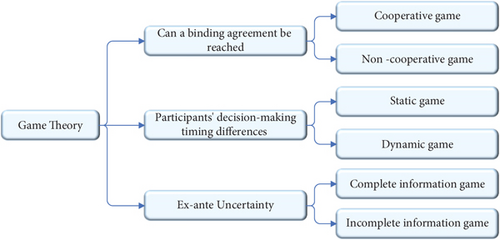
With the gradual advancement of smart grids and the energy Internet, the power network plays a leading role in the terminal energy consumption system. Many links of the modern power system, such as power generation, transmission, distribution, and power consumption, have diversified development characteristics. The interests of various participants in the power market environment are more complex. The game theory can solve the problem by optimizing multiple decision-making subjects. The combination of economic principles and power systems can accelerate the formation of a more optimized power market theory. The game theory becomes an important decision-making tool in the power market economy and provides a new solution to optimizing multiple participants in the power market [27].
(2) Multimicrogrid Scheduling Model. As an important part of the power system, power supply, power grid, and load interact frequently in the smart grid environment. There are various cross interests, which belong to different interest subjects. The construction, investment, and operation are managed and controlled by different subjects and are interconnected by power economic indexes, such as electricity quantity and electricity price, to distribute benefits [28]. The power system is a real-time demand balance system. Its safe and economic operation depends on the joint efforts of open sources, grids, and loads. The power system is a mature game system, and all subjects play games based on their interests, which is reflected by the mutual restriction and connection of safety indexes and economic indexes, such as the economic and reliable grid connection of power supply, the coordinated scheduling of the power grid, and the demand response of users’ loads, realizing multiparty equilibrium and protecting the interests of the whole power system [29].
2.4. Simulation Design
The strategy of each microgrid in the process of game bidding is simulated by the IEEE-9 bus system [30] based on the genetic algorithm (GA) [31], and simulation experiments are conducted by Matlab. The architecture of the multimicrogrid system based on IEEE-9 is shown in Figure 8.
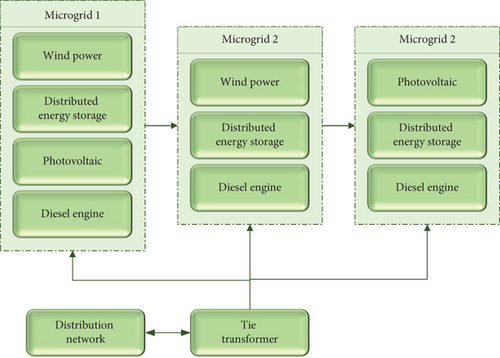
Microgrid 1 in the system only has photovoltaic and wind power, microgrid 2 only has wind power, and microgrid 3 only has photovoltaic power to show the differences between different microgrids. The controllable units in the system include diesel power generation units and distributed energy storage device, and their specific parameter settings are shown in Table 1.
| Types | Rated capacity/kW | Upper limit of output/kW |
Lower limit of output/kW |
Cost/kWh) | ||||||
|---|---|---|---|---|---|---|---|---|---|---|
| 1 | 2 | 3 | 1 | 2 | 3 | 1 | 2 | 3 | ||
| Diesel engine | 180 | 120 | 180 | 180 | 120 | 180 | — | — | — | 0.56 |
| Energy storage device | 100 | 60 | 60 | 15 | 8 | 8 | -15 | -8 | -8 | 0.08 |
The TOU price of peak load, average load, and valley load of the power grid is shown in Table 2.
| Peak load | Average load | Valley load | |||||
|---|---|---|---|---|---|---|---|
| 8 ~ 10 | 16~20 | 6 ~ 7 | 11~15 | 20~21 | 1 ~ 5 | 22~24 | |
| Electricity prices in different periods/(yuan/kWh) | 0.8655 | 0.6054 | 0.3864 | ||||
The parameter settings of GA are shown in Table 3.
| Parameters | Values |
|---|---|
| Times of iterations | 50 |
| Population size | 100 |
| Crossover probability | 0.6 |
| Variation probability | 0.1 |
3. Results of Simulation
3.1. Internal Optimization Results of Microgrids
The prediction results of renewable energy and load in each microgrid are shown in Figure 9.
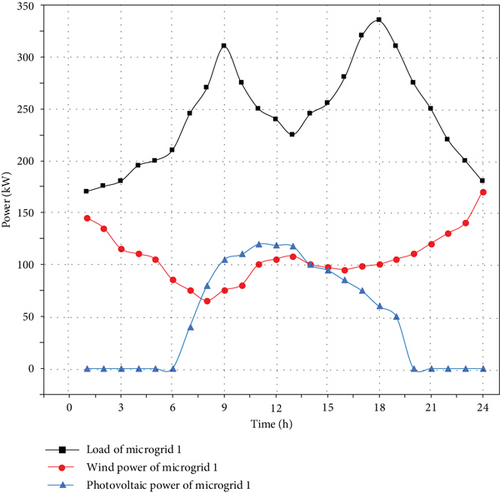
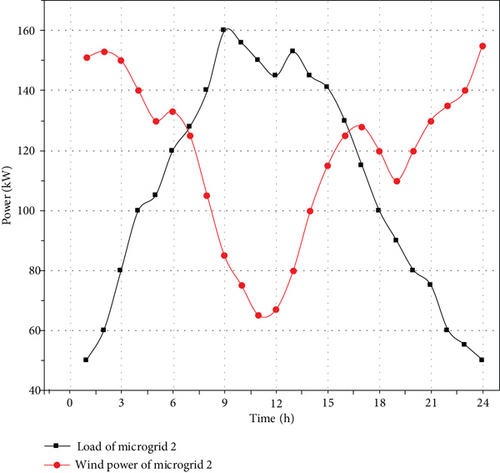
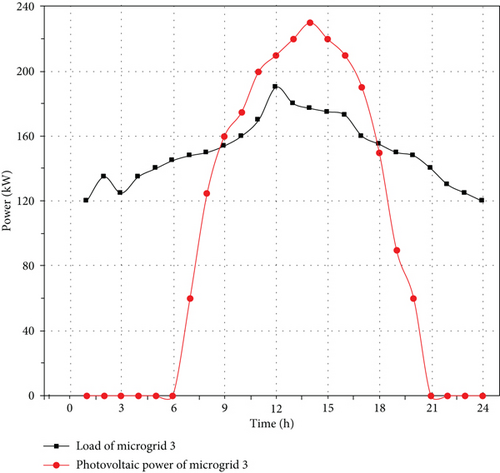
Figure 9 shows that microgrid 1 has a large power supply capacity and large load fluctuation due to the access of wind power and photovoltaic. Either microgrid 2 or 3 is connected, the power supply capacity and the load fluctuation are lower than microgrid 1. The capacity and load of microgrid 3 connected to photovoltaic are the lowest. Therefore, the simulation scheduling results of microgrid 1 are more representative. The optimization results of microgrid 1 are shown in Figure 10.
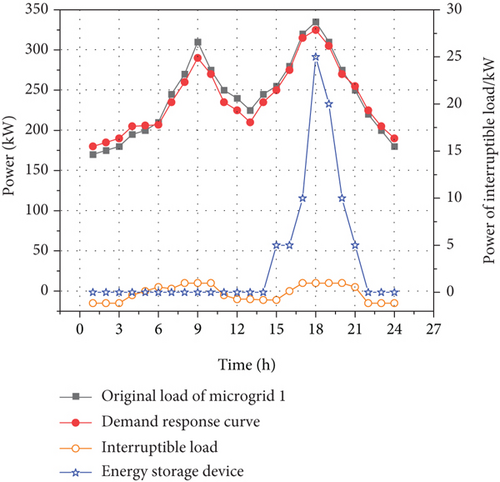
Figure 10 shows that the overall load of microgrid 1 is improved after optimization of the scheduling model. The peak load of a microgrid is 9 : 00 a.m. and 18 : 00 p.m; the photovoltaic power generation unit generates power and charges the energy storage device before the arrival of the early peak load. In the early peak load stage at 9 : 00, the TOU price strategy cooperates with the power supply of the energy storage device to realize load transfer. In the late peak load stage at 18 : 00, the power supply capacity of the energy storage device will be limited. Therefore, the interruptible load will be used as the standby power supply capacity between 15 : 00 and 20 : 00 to ensure the power supply reliability of the multimicrogrid system.
3.2. Multimicrogrid Game Interaction Results
The proposed hierarchical optimal scheduling model is used for simulation. The external power supply capacity of three microgrids and the bidding results of multimicrogrid based on game are shown in Figure 11.
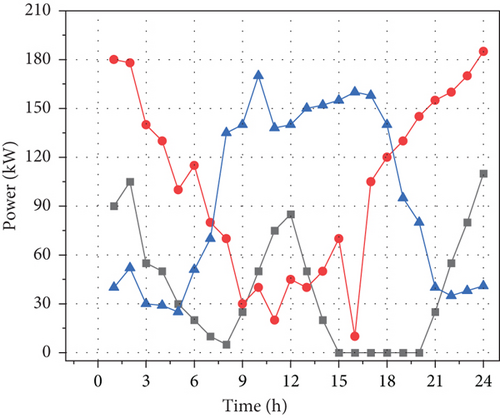
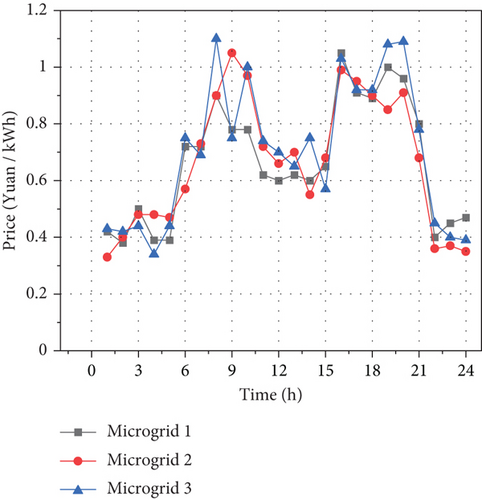
Figure 11(a) shows that the three microgrids supply external power at different stages of the day, and the curves are different. Microgrid 1 connected to wind power and photovoltaic at the same time mainly supplies power at noon and night, and microgrid 2 connected to wind power mainly supplies power in the morning and at night. Due to the large capacity of photovoltaic power generation at noon, microgrid 3 connected to photovoltaic power generation supplies power. In the multimicrogrid bidding based on the game theory, the surplus of renewable energy generation is given priority to sales. Figure 11(b) shows that the noon with high photovoltaic power supply and the night with high wind power supply are abundant in renewable energy, so the electricity price is generally low. Generally, the night wind period is mainly concentrated from 22 : 00 to 1 : 00 a.m., and Microgrid 2 takes a low bidding strategy at this stage. Microgrid 3, which can provide a large amount of photovoltaic residual power every day, does not need to take any bidding strategy, and it can be absorbed when there is a large load from 11 : 00 to 15 : 00 noon. The bidding strategy conforms to the time of use price mechanism. The price is higher than the peak load and lower than the valley load.
3.3. Optimal Power Output Results of Microgrids
The microgrid output power obtained by using the optimal bidding strategy and the income of the three microgrids are shown in Figure 12.
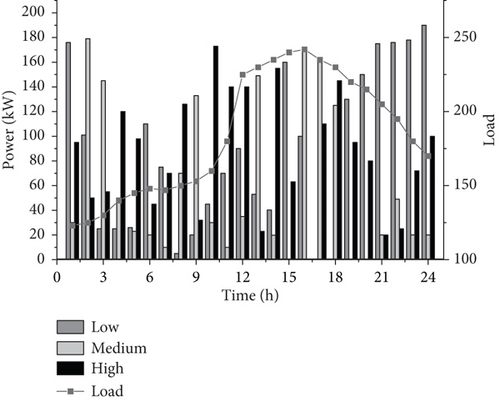

Figure 12(a) shows that “low”, “medium”, and “high” are the order of the optimal bidding of microgrids from low price to the high price at the corresponding time, and the curve is the load demand at each time. The low-cost microgrid has the priority of power supply. If the load demand cannot be met, the microgrid corresponding to the medium price is required to provide a coordinated power supply until the load demand is met. In combination with Figure 11, the selling prices of the three microgrids are ranked from low to high as 1 < 2 < 3 at noon. Therefore, microgrid 1 supplies power first and then superimposes the remaining power generation of microgrids 2 and 3 until the load demand is met. At 14 : 00, the prices of the three microgrids are ranked from low to high as 2 < 1 < 3. The power supply is carried out in this order, but the load demand is still not met. At this time, the power distribution shall be supplemented. Figure 12(b) shows that since a total load of microgrid 1 is the largest and the generation power is less, its load transfer capacity is 132.7 kW, which is helpful to the effective utilization of the “peak shaving” and “valley filling” functions of demand responses. For microgrids 2 and 3, only a small amount of load needs to be transferred to achieve the optimal power, which are 47.1 kW and 46.4 kW, respectively. The electricity sales of the three microgrids are 665.8 kWh, 2053.3 kWh, and 1668.2 kWh, respectively; the income is 132.45 CNY, 411.72 CNY, and 354.63 CNY, respectively. This shows that the game equilibrium index makes the power sales proportional to the income of each microgrid, ensuring the balance in the bidding process for order scheduling.
In short, the multimicrogrid demand response hierarchical optimal scheduling model based on the game theory can effectively optimize the scheduling strategy of the multimicrogrid system and finally obtain the optimal power trading scheme, improving the load of each microgrid in the system, realizing the balance of supply and demand, and saving resources and costs. The model has broad application prospects in active demand response scheduling optimization.
4. Conclusions
The microgrid system, which can effectively absorb renewable energy, is widely used in the construction of 5G base stations. It performs power grid scheduling through demand response. The traditional scheduling optimization model developed for a single microgrid is not suitable for multimicrogrid systems. Therefore, a new model is proposed. First, the response characteristics of the energy storage demand are analyzed. Second, a 5G base station microgrid hybrid power supply system is proposed. On this basis, a multimicrogrid demand response hierarchical optimal scheduling model based on the game theory is constructed. Finally, the strategy of each microgrid in the process of game bidding is simulated by GA, and the simulation experiment is carried out by Matlab based on the IEEE-9 bus system. The results show that the multimicrogrid system is optimized by the model, and the overall load of the microgrid is improved. The model carries out independent energy optimization according to the energy access of each microgrid and consumes renewable energy through demand response. The game-based time-sharing bidding strategy is taken and the system gives priority to the low-cost microgrid for power supply, ensuring the power supply quality and reducing the cost. The load transfer capacity of the three microgrids obtained by the model are 132.7 kW, 47.1 kW, and 46.4 kW, respectively, which is within the load range of each microgrid; the electricity sales of each microgrid are 665.8 kWh, 2053.3 kWh, and 1668.2 kWh, respectively. The income is 132.45 CNY, 411.72 CNY, and 354.63 CNY, respectively. The game equilibrium index makes the electricity sales in a proportional relationship with the income of each microgrid, which ensures the balance and order scheduling in the bidding process. The optimization model proposed can effectively use renewable energy and avoid resource waste. It can reduce cost and has broad application prospects in active demand response scheduling optimization. The shortcoming is that the cooperative game model of each microgrid in the multimicrogrid system is only discussed, but the non-cooperative game model is not discussed. In the future, the game theory is combined with demand responses to make a more deep analysis of the model. The research provides technical support for the construction of 5G base stations and the active demand response scheduling optimization of distribution networks.
Conflicts of Interest
The authors declare that they have no conflicts of interest.
Open Research
Data Availability
The data used to support the findings of this study are included within the article.



